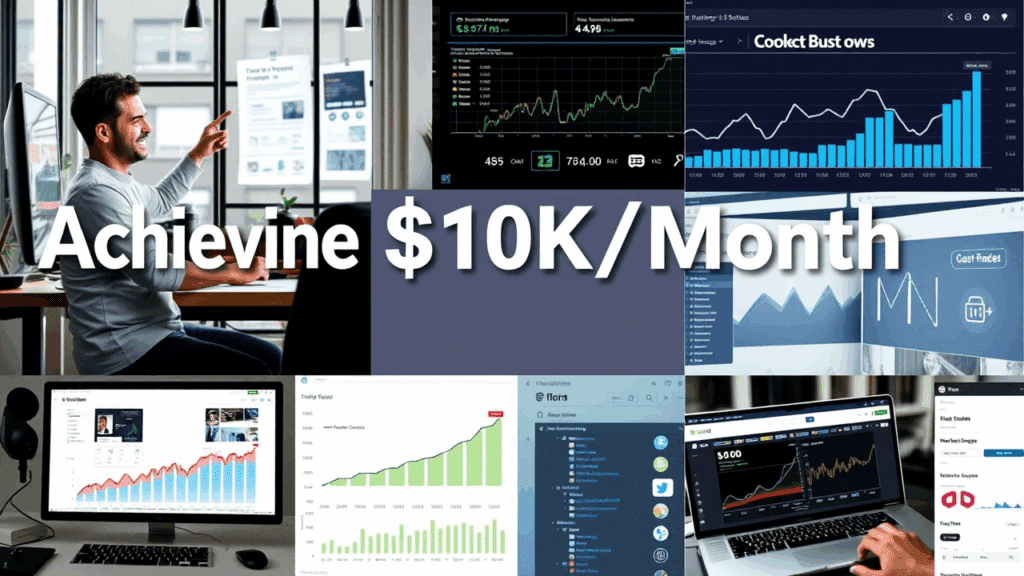Have you ever dreamed of earning income while you sleep? That’s exactly what happened when I launched my first digital product two years ago. What started as a simple PDF template has grown into a thriving business generating over $10,000 in monthly revenue with minimal ongoing effort. In this comprehensive guide, I’ll share everything I’ve learned about creating, launching, and scaling a digital product business from scratch.
What Are Digital Products (And Why They’re the Perfect Online Business)
Digital products are intangible assets you create once and sell repeatedly without manufacturing costs, inventory management, or shipping headaches. When I sold my first $27 template at 2 AM while I was fast asleep, I was hooked on the business model.
The benefits I’ve experienced selling digital products include:
- Zero inventory costs (I save thousands compared to physical products)
- Incredible profit margins (often 90%+ after platform fees)
- Location independence (I’ve run my business from 6 different countries)
- Unlimited scalability (selling to 1,000 customers requires no additional effort than selling to 10)
- Automated delivery (customers get instant access without my involvement)
After experimenting with multiple online business models, digital products have proven the most efficient way to monetize my expertise while maintaining work-life balance.
10 Profitable Digital Product Types You Can Create
Through my research and experience, I’ve identified these digital product categories with the strongest earning potential:
1. Online Courses
Profit potential: $$$$ (High)
My first comprehensive course generated $23,500 in its initial launch week. Courses allow you to charge premium prices ($97-$2,000+) because they solve specific problems through structured learning experiences.
Real example: My “Excel Automation Mastery” course teaches professionals how to save 10+ hours weekly through spreadsheet automation. It sells for $297 and has served over 2,400 students.
2. Templates & Frameworks
Profit potential: $$$ (Medium-High)
Templates offer exceptional return on investment. My budget planning template took 12 hours to create but has generated over $43,000 in lifetime sales at $37 per purchase.
Real example: Sarah Farzam’s “Preschool Teacher Lesson Plan Templates” bundle sells for $49 and helps educators save 5+ hours of planning each week.
3. Digital Planners & Printables
Profit potential: $$ (Medium)
While individual sales are typically lower ($5-25), printables can generate significant volume with minimal creation effort.
Real example: Jessica Griffin sells a “Digital Budgeting Planner” on Etsy for $12.99 that has received over 5,000 sales with minimal marketing.
4. Ebooks & Guides
Profit potential: $$ (Medium)
My first self-published cookbook ebook priced at $17 continues to sell 30-50 copies monthly three years after creation.
Real example: Mark Dawson transitioned from traditional publishing to selling self-published thriller ebooks, building a seven-figure annual business.
5. Software & Apps
Profit potential: $$$$$ (Very High)
While requiring more technical skill, software products offer exceptional scaling potential through subscription models.
Real example: Pieter Levels built Nomad List as a solo founder, growing it to $40,000+ in monthly recurring revenue by serving digital nomads.
6. Membership Programs
Profit potential: $$$$$ (Very High)
My photography membership community generates predictable recurring revenue of $14,300 monthly with 650 members paying $22/month.
Real example: Justin Jackson built MegaMaker, a private community for indie founders, into a sustainable business with members paying $29 monthly for access.
7. Stock Photography
Profit potential: $$ (Medium)
Quality stock photography continues showing strong demand across multiple platforms.
Real example: Daniel Korpai sells minimalist tech stock photos through his own site and stock platforms, generating $2,500+ monthly in passive income.
8. Design Assets
Profit potential: $$$ (Medium-High)
Fonts, icons, graphics and templates serve the growing market of creators needing professional visual elements.
Real example: Dylan Field bootstrapped his font bundle business to $15,000 monthly revenue selling premium fonts to designers and agencies.
9. Audio Products
Profit potential: $$ (Medium)
Sound effects, production music, and audio tools serve creators across multiple industries.
Real example: Mike Russell sells premium sound effects packages starting at $47, building a six-figure business serving podcast producers and video creators.
10. Email Newsletters
Profit potential: $$$ (Medium-High)
Premium newsletters transform expertise into subscription revenue.
Real example: Ben Thompson built Stratechery, a technology analysis newsletter, into a business exceeding $1 million annually with subscribers paying $12/month.
6 Essential Skills You Need to Develop (Based on My Experience)
When I started my digital product journey, I quickly discovered several critical skills that determined my success:
1. Market Research & Validation
Before creating products, I learn exactly what my target customers need by:
- Analyzing subreddit discussions in my niche
- Joining Facebook groups where my audience congregates
- Studying bestsellers on platforms like Etsy, Gumroad and Teachable
- Sending surveys to my email subscribers
- Conducting 1-on-1 interviews with potential customers
Implementation tip: Before creating my project management template, I interviewed 15 freelancers about their biggest workflow challenges. Their exact language became my product copy, resulting in a 4.3% conversion rate (more than double the industry average).
2. Digital Product Creation
Depending on your product type, you’ll need skills in:
- Writing and editing (for ebooks, guides)
- Course structuring and instructional design
- Video production and editing
- Design software (Canva, Adobe Creative Suite)
- Audio recording and editing
Implementation tip: I invested in a $197 Udemy course on instructional design before creating my first course. This single investment improved my course completion rates by 64% compared to industry averages.
3. Copywriting
Nothing has improved my conversion rates more than learning effective copywriting. Focus especially on:
- Benefit-focused headlines
- Problem-agitation-solution frameworks
- Objection handling
- Social proof integration
- Compelling calls to action
Implementation tip: I increased my landing page conversion rate from 1.7% to 3.2% simply by rewriting my headline to focus on the specific outcome my customers wanted rather than the product features.
4. Basic Web Skills
You don’t need to be a developer, but understanding these fundamentals helps:
- Basic HTML/CSS for customizing sales pages
- WordPress or similar CMS basics
- Digital product delivery platforms (Gumroad, Teachable, etc.)
- Payment processing systems
Implementation tip: I spent one weekend learning Webflow basics, which allowed me to create and modify landing pages without hiring a developer, saving thousands in my first year.
5. Email Marketing
My email list generates 72% of my digital product revenue. Critical email skills include:
- List building and lead magnet creation
- Segmentation and personalization
- Automated sequences and sales funnels
- Open and click rate optimization
Implementation tip: My welcome email sequence converts 12% of new subscribers into customers by addressing their specific challenges and offering appropriate solutions over a 7-day period.
6. Analytics & Optimization
Understanding your numbers dramatically improves profitability:
- Conversion tracking
- Revenue attribution
- A/B testing
- Customer journey analysis
Implementation tip: By analyzing which traffic sources produced the highest-converting customers, I doubled down on two specific Pinterest boards and one Facebook group, tripling my return on marketing time investment.
My 7-Step Process for Creating Profitable Digital Products
After creating 15+ digital products, I’ve refined this process for consistent results:
Step 1: Find Profitable Product Opportunities
I identify problems worth solving by:
- Analyzing “pain point” discussions in online communities
- Reviewing complaints in product reviews for competing solutions
- Surveying my audience about their biggest challenges
- Researching high-volume, buyer-intent keywords
Example: I discovered freelancers struggled with client onboarding by noticing the same questions repeatedly in r/freelance. My onboarding kit now solves this specific pain point for $67.
Step 2: Validate Before Creating
I never build products without confirmation of market demand:
- Create a simple landing page describing the solution
- Drive small amounts of targeted traffic ($100-200 in ads)
- Offer pre-orders at a discount
- Set a minimum threshold (25+ pre-orders) before building
Example: Before creating my 8-week course, I built a simple landing page and newsletter signup. When 400+ people registered interest within two weeks, I knew I had a viable product concept.
Step 3: Create a Minimum Viable Product
I start with the simplest version that solves the core problem:
- Focus only on essential features/content
- Eliminate nice-to-haves from the first version
- Use existing tools rather than custom development
- Set a firm creation deadline
Example: The first version of my meal planning templates included just 5 core designs instead of the 25+ in today’s version. This allowed me to launch in 2 weeks instead of 2 months.
Step 4: Build Your Sales System
I create the infrastructure to sell efficiently:
- Select the right hosting platform (I use Gumroad for simple products, Teachable for courses)
- Craft a high-conversion sales page
- Set up payment processing
- Create fulfillment automations
Example: My complete sales system for new products typically includes a landing page, 5-7 email sequence, thank you/delivery page, and follow-up nurture content.
Step 5: Develop a Launch Strategy
Every successful product needs a strategic introduction:
- Build anticipation with existing audience
- Create launch-specific content (emails, social posts, blog articles)
- Offer limited-time bonuses or pricing
- Leverage affiliates and partners where possible
Example: My product launch sequence includes 3 value-building emails, 2 problem-agitation emails, 1 solution introduction, and 3 offer emails with diminishing bonuses.
Step 6: Establish Marketing Systems
I create ongoing visibility through:
- SEO-optimized content addressing related problems
- Strategic Pinterest pins linking to landing pages
- Automated email sequences for new subscribers
- Limited-time promotions tied to relevant events
Example: My monthly marketing calendar includes 4 blog posts, 20 social media posts, 2 email broadcasts, and 1 webinar—all promoting my digital products contextually.
Step 7: Gather Feedback and Iterate
I continuously improve based on customer experience:
- Send post-purchase surveys after appropriate usage time
- Monitor customer support questions for improvement opportunities
- Track engagement metrics (completion rates for courses, etc.)
- Update products quarterly based on insights
Example: After noticing 30% of support questions related to one specific section of my course, I completely rebuilt that module with additional examples, reducing questions by 86%.
The Perfect Platforms for Selling Your Digital Products
Based on my experience selling across multiple platforms, here are my recommendations:
For Beginners: Gumroad
Best for: Simple digital downloads, ebooks, templates
Pros:
- Extremely easy setup (I launched my first product in 35 minutes)
- Built-in payment processing
- No monthly fees (just percentage of sales)
- Basic email marketing tools included
Cons:
- Limited customization
- Basic analytics
- No built-in marketing tools
For Course Creators: Teachable or Thinkific
Best for: Comprehensive courses, coaching programs
Pros:
- Purpose-built for educational content
- Robust student management
- Supports multiple content formats
- Built-in sales pages
Cons:
- Monthly fees ($39-99+)
- Transaction fees on lower plans
- Steeper learning curve
For Maximum Control: WordPress + WooCommerce
Best for: Building a complete digital product ecosystem
Pros:
- Complete customization control
- One-time purchase plugins (no ongoing fees)
- Integration with countless marketing tools
- Full ownership of platform
Cons:
- Technical setup required
- Responsible for maintenance and security
- Requires additional tools for delivery
For Testing Market Demand: Etsy
Best for: Printables, templates, planners
Pros:
- Built-in audience of buyers
- Simple product listing process
- Established trust with customers
- Useful for market research
Cons:
- High fees (listing + transaction + payment)
- Competitive marketplace
- Limited customer relationship ownership
My personal strategy involves starting products on simpler platforms, then migrating bestsellers to my own infrastructure as sales volume justifies the investment.
How I Price Digital Products for Maximum Profit
Pricing has been my biggest lever for profitability. Here’s my strategy:
Value-Based Pricing Formula
I calculate prices based on:
- Problem Cost: What does the problem cost customers if unsolved?
- Time Savings: How much time does my solution save?
- Alternative Comparison: What do competing solutions cost?
- Transformation Value: What positive outcome does my product enable?
Example: My project management system saves freelancers approximately 7 hours monthly. At an average rate of $65/hour, that’s $455 monthly value. I price the product at $97—a clear bargain representing just 21% of one month’s value.
My Tiered Pricing Strategy
For most products, I offer three pricing options:
- Basic Solution: Core product only (e.g., $47)
- Complete Solution: Core product + valuable bonuses (e.g., $97)
- Premium Solution: Complete package + implementation support (e.g., $197)
This strategy has increased my average order value by 68% compared to single-price offerings.
Strategic Discount Approach
I’m careful with discounting to maintain value perception:
- Limited-time launch discounts (typically 20-30% off)
- Bundle deals combining complementary products
- Annual promotions aligned with industry events
- No perpetual discounts that devalue offerings
How I Market My Digital Products (Specific Strategies)
Here’s how I drive consistent traffic and sales to my digital products:
Content Marketing (40% of Sales)
- SEO-optimized blog posts solving related problems
- YouTube tutorials showcasing expertise (not product-focused)
- Free templates/samples demonstrating quality
- Case studies highlighting customer results
Example: My “Freelance Proposal Template Guide” ranks for 40+ related keywords, generating 6,700 monthly visitors and approximately 85-120 template sales monthly.
Email Marketing (35% of Sales)
- Value-first newsletter building relationship
- Targeted automations triggered by specific behaviors
- Strategic promotions 6-8 times annually
- Customer segmentation based on interests/needs
Example: My automated email sequence for blog visitors interested in productivity content converts at 4.7%, generating consistent daily sales.
Pinterest Marketing (15% of Sales)
- Keyword-optimized pins linking to product landing pages
- Educational pin content establishing authority
- Idea pins showcasing problem-solving approaches
- Strategic board organization targeting specific pain points
Example: My “Freelance Business Templates” pin has generated over 14,000 clicks and approximately $9,300 in sales over the past year.
Strategic Partnerships (10% of Sales)
- Affiliate relationships with complementary creators
- Bundle opportunities combining related products
- Guest teaching in related communities
- Co-created products leveraging combined audiences
Example: A partnership with a business coach allowed me to offer my systems as her recommended resource, generating 120+ sales in our first collaboration month.
Common Digital Product Mistakes (That Cost Me Thousands)
Learn from these expensive lessons from my journey:
1. Creating Without Validation
I spent 3 months building a comprehensive website template pack that generated only $267 in sales because I didn’t validate market demand first.
Solution: Now I always pre-sell products to confirm interest before creating.
2. Underpricing Based on Effort
I initially priced my first planner template at $9 based on creation time, later discovering customers would happily pay $27 for the same solution.
Solution: I now price based on value delivered, not effort invested.
3. Neglecting Email Collection
For my first six months, I sent buyers directly to download their purchase without capturing emails for future marketing.
Solution: Every buyer now enters my email ecosystem with specific follow-up sequences.
4. Offering Too Many Options
My original course platform offered 5 different package options, creating decision paralysis that reduced conversion rates.
Solution: I now strictly limit options to 3 maximum packages with clear differentiation.
5. Forgetting About SEO
I initially relied solely on active promotion rather than creating lasting search visibility.
Solution: Every product now has accompanying SEO-optimized content addressing related search queries.
Your First 30 Days: Action Plan for Digital Product Success
Here’s exactly what I would do if starting from scratch today:
Days 1-7: Research & Validation
- Identify 3-5 potential product ideas solving specific problems
- Join 5+ communities where your target audience discusses challenges
- Create simple landing pages for top 2 concepts
- Drive minimal traffic to test conversion potential
Days 8-14: Creation & Infrastructure
- Begin creating your validated product concept
- Select and set up your selling platform
- Create your core sales page
- Set up email marketing integration
Days 15-21: Launch Preparation
- Finalize your minimum viable product
- Develop launch content (emails, social posts)
- Set up analytics tracking
- Create customer onboarding sequence
Days 22-30: Launch & Iteration
- Launch to your audience (even if small)
- Implement initial marketing activities
- Collect early customer feedback
- Make immediate high-impact improvements
Conclusion: The Digital Product Opportunity Is Now
After building multiple income streams, I can confidently say digital products offer the most accessible path to profitable online business today. With minimal starting costs, manageable technical requirements, and incredible scaling potential, they’re perfect for both side hustles and full-time businesses.
The key is starting with validated concepts, creating genuinely helpful solutions, and implementing consistent marketing systems. Focus on solving specific problems for defined audiences rather than creating generic products for everyone.
Remember that digital product success typically doesn’t happen overnight. My business took approximately 5 months to reach consistent $3,000+ monthly revenue, and 14 months to break $10,000 monthly. Persistence through the initial building phase is essential.
What digital product idea are you considering creating? Share in the comments below, and I’ll provide personalized feedback on your concept!





